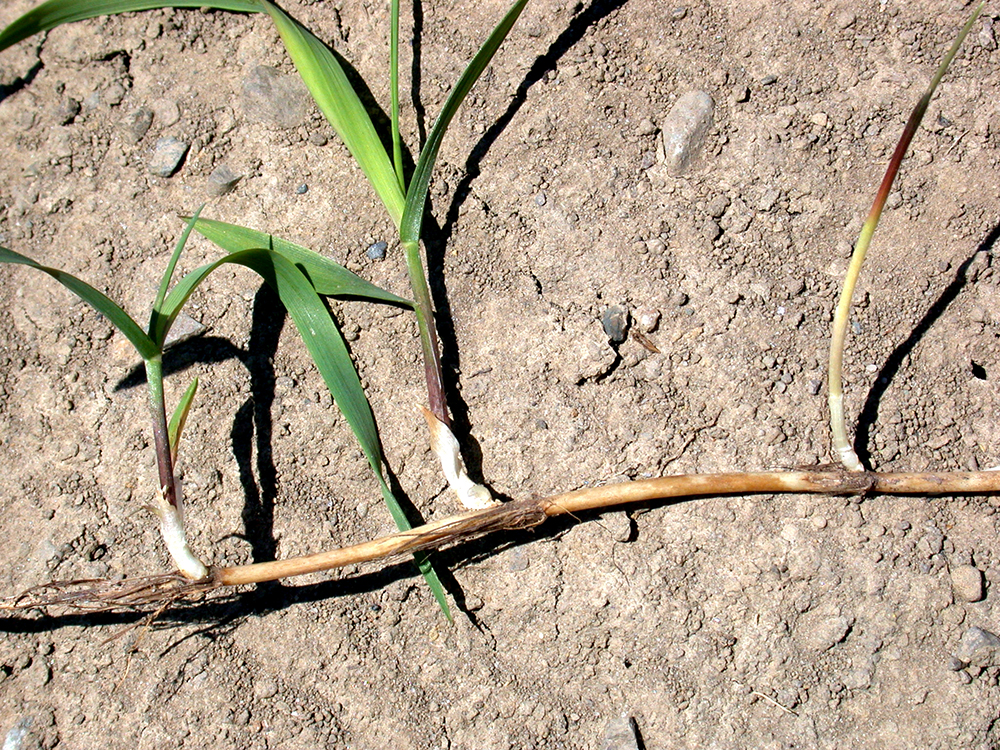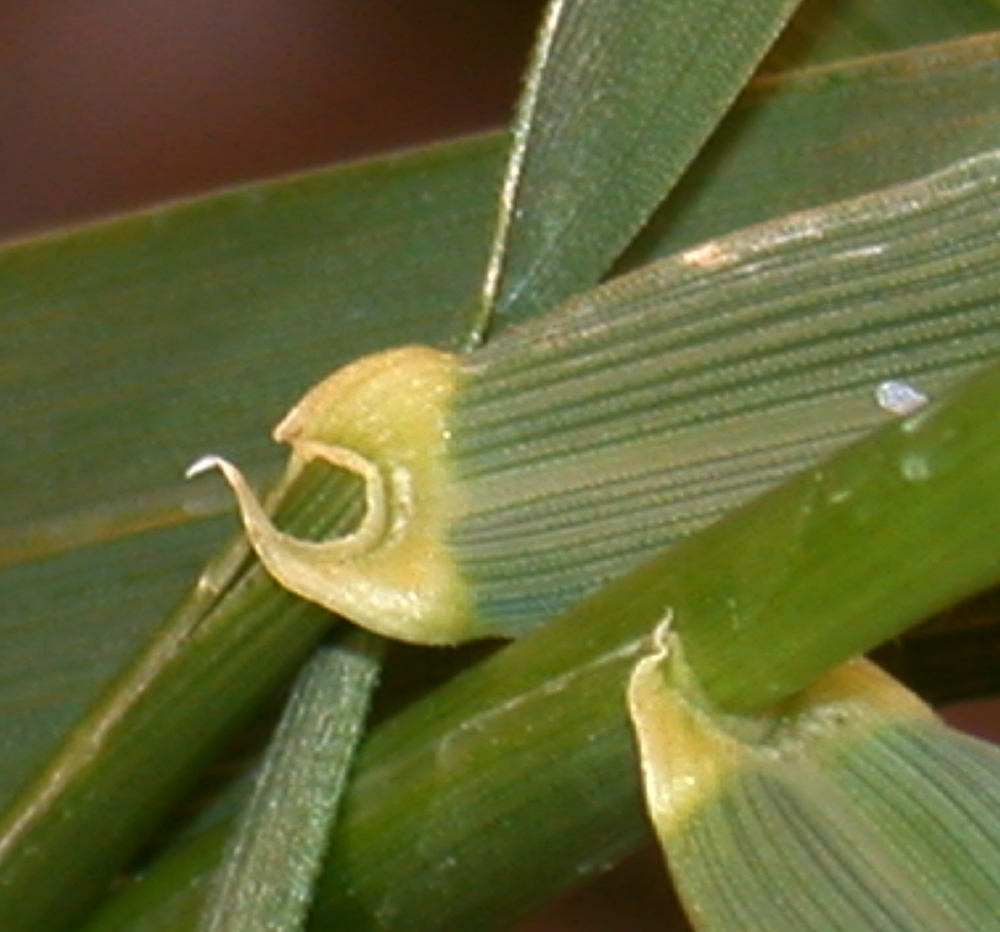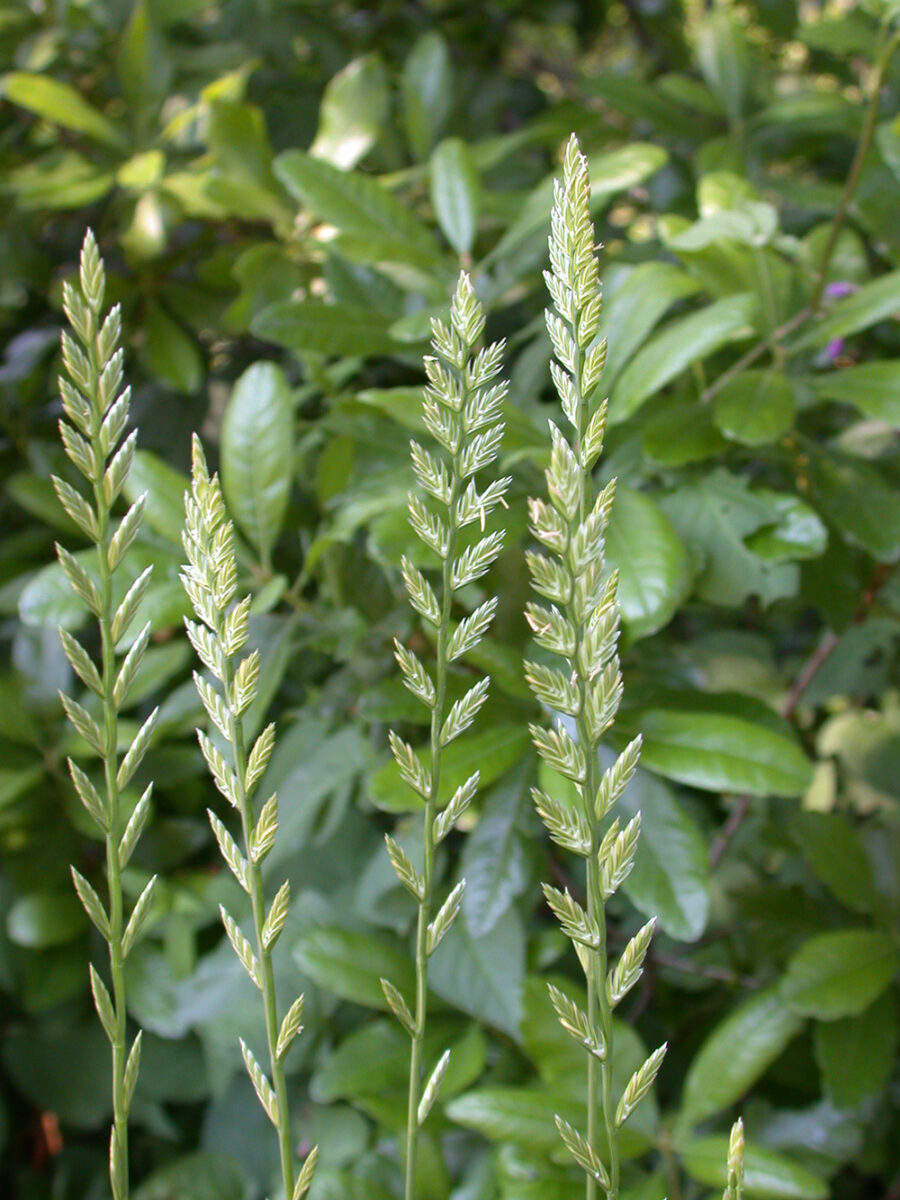Other common names: quitch grass, couch grass, wheat grass, shelly grass, knot grass, scotch grass, quick grass, twitch grass, witchgrass, devil’s grass, bluejoint, pondgrass, Colorado bluegrass, false wheat, dog grass, seargrass, quickens, wickens, stroil



Elymus repens (L.) Gould = Elytrigia repens (L.) Desv. ex Nevski = Agropyron repens (L.) P. Beauv.
Identification of Quackgrass
Family: Grass family, Poaceae
Habit: Perennial grass, spreading by shallow rhizomes
Description: Seedlings are upright, and the long and narrow seed leaf grows vertically. Leaves of the seedling are rolled in the bud, smooth below and hairy to smooth above, and 3.5–8 inches long by 0.08–0.1 inch wide. The ligule is less than 0.02 inch long and membranous, and auricles are small and often inconspicuous. The sheath is smooth to hairy, and the collar is prominently veined and whitish to pale green. Mature quackgrass is upright, unbranched and can reach 4 feet in height. Leaves are rolled in the bud, and a pair of narrow auricles clasps the stem at the base of each leaf blade. The ligule is translucent, membranous and less than 0.04 inch long. The sheath is open at the top and hairless to hairy. Often the sheath of the bottom-most leaf is hairy whereas the sheaths of other leaves are nearly hairless. Leaf blades are 6–16 inches long and 0.12–0.4 inch wide. The root system is composed of spreading rhizomes with pointed tips and fibrous roots at the nodes. The rhizomes can spread up to 24 inches horizontally and extend to 8 inches below the soil surface. The inflorescence is a 2–8 inch-long, flattened spike with two alternating rows of numerous 0.4–0.6 inch-long spikelets. The spikelets may have 0.07–0.4 inch-long awns at the tips. The inflorescence turns from greenish blue to straw colored as it matures. Each spikelet produces four to six tan, narrow, oblong, 0.04–0.2 inch-long seeds. As with all grasses, the apparent seed includes a tight, thin outer layer of fruit tissue.
Similar species: Tall fescue [Schedonorus arundinaceus (Schreb.) Dumort.], ryegrass (Lolium) species and smooth brome (Bromus inermis Leyss.) may all be mistaken for quackgrass. Tall fescue is a clump forming grass that lacks rhizomes and has blunted auricles that do not wrap around the stem like those of quackgrass. Ryegrasses may have similar auricles to quackgrass but do not have rhizomes. Smooth brome develops rhizomes, but it lacks auricles and has closed sheaths.
Management of Quackgrass
Quackgrass tends to increase when the crop rotation includes frequent spring cereal grains and legume forage crops. The former provide little competitive pressure during quackgrass’ prime spring growth period, and the latter provide nitrogen and a long period for undisturbed growth of the rhizomes. Since control of severe infestations of quackgrass without the use of herbicides largely requires repeated or intensive tillage, preventing buildup of populations is critical for the maintenance of soil health.
The fastest way to rapidly control a severe quackgrass infestation is to thoroughly dry out the rhizomes. The traditional English method is to plow the soil when it is wet so that it becomes cloddy. Then stir the clods repeatedly during dry weather so that the whole plow layer becomes thoroughly dry. A less effective method that does not require such a long fallow begins by tilling the soil with a chisel plow or field cultivator at the beginning of a dry period. The aim of the tillage is to loosen the soil around the rhizomes while leaving the rhizome pieces as long as possible. Then use a spring tooth harrow to work the rhizomes to the soil surface to dry. Use the harrow every few days to speed drying of the soil and bring more rhizomes to the surface so that most dry thoroughly before the next rain. If the infestation is particularly dense and the field is small, you can remove a substantial percentage of the rhizomes by bringing them to the surface as explained above and then raking them onto the field margins. A window of opportunity for this approach is often available in late summer after harvest of a cereal grain or short season vegetable crop. Beginning tillage immediately after harvest and preventing fall quackgrass growth is more important than repeated cultivations later in fall.
The principal approach for managing moderate quackgrass populations involves regular depletion of storage reserves in the rhizomes. Rhizome reserves are at a minimum when the shoot has developed three leaves, so try to target tillage and cultivation at that growth stage, but disturbance is useful whenever the shoot is showing. The first tillage of the year should be aimed at cutting the rhizomes into the smallest pieces possible. Thus, beginning with rotary tillage or disking is more effective than moldboard or chisel plowing. Following the initial tillage with moldboard plowing, however, is often useful for placing the small rhizome pieces deep in the soil. They will then have to use up substantial reserves to reach the surface. Buds on quackgrass rhizomes will sprout at any time during the growing season, so many opportunities to deplete reserves occur before and after a summer crop. For example, before soybeans or a summer vegetable crop, till the soil when quackgrass begins to grow and then delay a few weeks before preparing a seedbed. Unlike a re-worked seedbed for depleting a surface seed bank, however, tillage for seedbed preparation should work the top 6 inches to disturb as many rhizome fragments as possible. If necessary, this procedure can be repeated in the fall after harvest, followed by winter grain as a cash or cover crop. A dense, vigorous stand of winter grain like wheat will competitively suppress quackgrass. When row crops are in the ground, continue to cultivate as long as you can get between the rows safely. The more times the quackgrass shoots are cut off at about the three-leaf stage, the more you will weaken the rhizomes.
Obviously, the intensive tillage discussed above will tend to deplete soil organic matter and pose a potential erosion risk. Consequently, they should be used only when quackgrass has become a severe problem or appears likely to become so. Moreover, when using these practices, you should compensate for the reduced soil organic matter by incorporating cover crops into the crop rotation. Also, proper equipment can reduce the impact of quackgrass control practices on soil health. For example, a field cultivator equipped with broad, shallow sweeps can be run shallowly after crop harvest to cut off quackgrass shoots while maintaining crop residue on the soil surface. When cultivating row crops, shallow low-pitch blades will sever the quackgrass shoots with less oxidation of soil organic matter and disturbance of crop roots than more conventional sweeps and shovels.
Additional approaches for controlling quackgrass that do not include tillage and are not destructive of soil quality include mowing and interseeded cover crops. Repeated post-harvest mowing reduced rhizome production and increased grain yield in the subsequent year. Under-sown cover crops also have the potential to control quackgrass if they can attain growth of at least 900 pounds per acre. Interseeding red fescue with a winter wheat cash crop at planting will suppress quackgrass, but red clover can actually benefit rhizome production.
Quackgrass density usually increases in hay and pasture. Although quackgrass is nutritious and causes negligible economic loss in the hay crop, you will likely have increased quackgrass when rotating back to annual crops. Consequently, try to get the quackgrass well under control before sowing the forage.
Ecology of Quackgrass
Origin and distribution: Quackgrass is native to Europe, but it has spread throughout the temperate regions of the world, including North and South America, Asia and Australia. It is found throughout the United States (including parts of Alaska) and in all Canadian provinces but is primarily a problem weed only in the northern states. It is uncommon in dry regions.
Seed weight: 2 mg.
Dormancy and germination: Quackgrass seeds germinate best when exposed to day/night temperature fluctuations of 77/59°F. Few seeds will germinate at any constant temperature from 41–86°F. Newly shed quackgrass seeds are not dormant and require no after-ripening. Rhizome buds can become dormant in late spring and early summer. This condition can be broken by nitrate or when a rhizome segment is severed from the parent plant.
Seed/bud longevity: A few seeds may remain viable in undisturbed soil for 10 years or more, but in normal field conditions few will survive longer than three years. In Alaska, undisturbed seeds declined by 59% per year. Rhizome bud viability declines rapidly in the first year, but it takes two years for all to die.
Season of emergence: Seedlings emerge in spring into summer, but these are uncommon. In undisturbed sod, shoots emerge in early spring, whereas shoots arising from the tips of new rhizomes emerge in late summer and fall. If the rhizomes are broken by tillage or hoeing, however, new aboveground shoots will arise from the terminal bud of rhizome fragments within a few days regardless of the season. However, in Sweden, shoot development from exhumed rhizomes declined in fall in response to shortening day length, but increased again in late fall to spring after exposure to freezing temperatures.
Emergence depth: Peak seedling emergence occurs from seeds that are within 0.5 inch of the soil surface, but an occasional seedling may come up from as deep as 4 inches. Shoots can arise from rhizomes at 10 inches or deeper, though few rhizomes occur naturally at such depths. In general, from smaller rhizome segments, shoots emerged in highest proportions from 1–2 inches, whereas from larger segments, shoots emerged from depths to 6 inches.
Photosynthetic pathway: C3
Sensitivity to frost: Quackgrass is highly frost tolerant, and green leaves commonly survive the winter in the northern United States. Rhizome bud populations can increase at temperatures above 32°F, so control late into fall is advised. Quackgrass rhizomes are killed by freezing at temperatures below 20°F. Since soil and snow are both good insulators, the rhizomes generally need to be on the soil surface during cold, snow free weather to freeze.
Drought tolerance: The species is moderately drought tolerant. Rhizomes can regenerate after up to 60% desiccation. Therefore, to kill rhizomes, they need to be left on the soil surface during hot, dry weather to thoroughly dry.
Mycorrhiza: Mycorrhiza have been reported as present on quackgrass, but mycorrhiza is absent from some populations and has been classified as a weak host.
Response to fertility: Quackgrass is highly responsive to fertilization with N but responds little to P or K. It is a luxury consumer of nutrients. It can persist in low fertility soils but is not vigorous under such conditions.
Soil physical requirements: Quackgrass does well on a variety of soil textures from coarse sands to heavy clays and on drainage classes from well to poorly drained. It is also tolerant of salt.
Response to shade: Quackgrass is slightly shade tolerant. It will persist (without vigor) in meadows of taller vegetation like goldenrod but is absent from forests. A reduction in level of light produces an increase in the percentage of rhizome buds developing as shoots. Only when light is reduced by 97% does rhizome formation cease.
Sensitivity to disturbance: The rhizomes are mostly distributed in the top 4 inches of an untilled sod where they tend to be cut up during tillage or spading. This increases the number of shoots but decreases the vigor of each shoot.
Time from emergence to reproduction: Shoots begin growing vigorously in early spring and flower from June through August. Long 16-hour days promote formation of elongated stems and inflorescences, but as day length shortens to 12 hours or less, plants shorten and stop producing inflorescences. New rhizomes develop when plants have three to four leaves if they develop from established rhizomes but at six to eight leaves when they develop from seedlings.
Pollination: The species is wind pollinated and self-sterile.
Reproduction: Quackgrass reproduces both vegetatively and by seeds. It typically produces 25–40 seeds per stem. However, seedlings are rarely observed, probably because many seeds are sterile. The species requires cross-pollination, and many populations apparently consist of just one to a few clones, making effective pollination difficult. Seed production serves mainly to disperse the species between sites rather than to maintain the population at a particular site. Most reproduction in a given field or garden is vegetative, with shoots arising from the tips of each rhizome branch. Rhizomes can spread up to 10 feet per year from the parent plant. A single rhizome node planted in late fall in Pennsylvania produced 14 rhizomes with a total length of 458 feet by the following fall. If tillage or deep hoeing breaks rhizomes, most segments will produce an aboveground shoot. These shoots become independent of the rhizome fragment at the five-leaf stage and begin producing new rhizomes at the three- to four-leaf stage. In heavily infested fields, rhizomes can weigh as much as 7–9 tons per acre. Production of new rhizomes is favored by a moderate temperature of 70°F with long day length typical of May or June conditions. In contrast, production of rhizomes that grow upward to establish new shoots is favored by either a low temperature of 50°F, such as occurs in April or November, or by a high temperature of 90°F, as occurs during mid-summer.
Dispersal: Seeds are dispersed in hay used for mulch, in manure and as a contaminant of grain seed (e.g., used for cover crops). The rhizomes are commonly dispersed on tillage machinery. Rhizomes are also sometimes dispersed in the soil surrounding the roots of nursery stock.
Common natural enemies: Agropyron mosaic virus causes yellow streaking of younger leaves but does little to reduce the vigor of the plant. Cattle, sheep and horses find quackgrass desirable forage. Pigs will grub out the rhizomes and eat them.
Palatability: Quackgrass is a good forage species with comparable nutritive value, fiber, digestibility and palatability to other perennial forage grasses.Note: Quackgrass has demonstrated allelopathic effects, which may partly explain the competitiveness of this species.
Summary Table of Quackgrass Characteristics
| Quackgrass | ||||||||
|---|---|---|---|---|---|---|---|---|
| Growth habit | Perennial overwinter organ | Emergence period from perennial organs | Optimum emergence depth (inches) from perennial organs | Time/stage of lowest reserves | Photosynthesis Type | Frost tolerance | Drought tolerance | Mycorrhiza |
| short grass | rhizomes | early spring | 1–6 | 3 leaves | C3 | high | moderate | no |
| Fertility Response | Importance of seeds to weediness | Seed weight (mg) | Dormancy of shed seeds | Factors breaking dormancy | Optimum temperarature range (F) for seed germination | Seedling emergence period | Emergence to flowering (weeks) | |
| high | low | 2 | no | at | 77/59 | spring | 8–12 | |
Table Key
Perennial overwinter organ: Principal plant organ that survives winter and from which growth resumes in subsequent years.
Emergence period from perennial organs: Time of year when most emergence occurs from perennial overwintering organs in the typical regions of occurrence for each weed. Some emergence may occur outside of this range.
Optimum emergence depth from perennial organs: Soil depths (in inches below the soil surface) from which most shoots emerge from perennial organs. Lower rates of emergence usually will occur at depths above or below this range.
Time/stage of lowest reserves: Time of year and/or weed growth stage at which carbohydrate reserves are lowest. This usually corresponds to the time when the weed is most susceptible to weed management operations.
Frost tolerance: Relative tolerance of aboveground shoots to freezing temperatures (high, moderate, low).
Drought tolerance: Relative tolerance of aboveground plants to drought (high, moderate, low).
Importance of seeds to weediness: The relative importance of seeds to dispersal, genetic diversity and survival of the species as a weed in agricultural environments (high, moderate, low). Emergence to flowering: Length of time (weeks) after emergence from perennial organs to the beginning of flowering in the typical regions of occurrence. Note that this refers to established perennial plants, recognizing that some species may not flower in their initial year of establishment.
Further Reading
Brandsӕter, L.O., M. Goul Thomsen, K. Wӕrnhus and H. Fykse. 2012. Effects of repeated clover undersowing in spring cereals and stubble treatments in autumn on Elymus repens, Sonchus arvensis and Cirsium arvense. Crop Protection 32: 104–110.
Majek, B.A., C. Erickson and W.B. Duke. 1984. Tillage effects and environmental influences on quackgrass (Agropyron repens) rhizome growth. Weed Science 32: 376–381.
Palmer, J.H. and G.R. Sagar. 1963. Agropyron repens (L.) Beauv. (Triticum repens L.; Elytrigia repens (L.) Nevski). Journal of Ecology 51: 783–794.
Ringselle, B., G. Bergkvist, H. Aronsson and L. Andersson. 2015. Under-sown cover crops and post-harvest mowing as measures to control Elymus repens. Weed Research 55, 309–319.
Werner, P.A. and R. Rioux. 1977. The biology of Canadian weeds. 24. Agropyron repens (L.) Beauv. Canadian Journal of Plant Science 57: 905–919.

